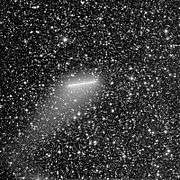Gordon J. Garradd
| (6027) 1993 SS2 | September 23, 1993 | MPC |
| (6874) 1994 JO1 | May 9, 1994 | MPC |
| (8201) 1994 AH2 | January 5, 1994 | MPC |
| (10150) 1994 PN | August 7, 1994 | MPC |
| (10180) 1996 EE2 | March 15, 1996 | MPC |
| (10578) 1995 LH | June 5, 1995 | MPC |
| (10824) 1993 SW3 | September 24, 1993 | MPC |
| (14916) 1993 VV7 | November 10, 1993 | MPC |
| (14921) 1994 QA | August 16, 1994 | MPC |
| (23621) 1996 PA | August 5, 1996 | MPC |
| (24814) 1994 VW1 | November 10, 1994 | MPC |
| (26895) 1995 MC | June 23, 1995 | MPC |
| (30956) 1994 QP | August 27, 1994 | MPC |
| (37651) 1994 GX | April 3, 1994 | MPC |
| (55820) 1995 FW | March 25, 1995 | MPC |
| (55843) 1996 PD1 | August 9, 1996 | MPC |
| 61342 Lovejoy | August 3, 2000 | MPC |
| (65757) 1994 FV | March 21, 1994 | MPC |
| (69350) 1993 YP | December 17, 1993 | MPC |
| (69357) 1994 FU | March 21, 1994 | MPC |
| (96298) 1996 RE26 | September 9, 1996 | MPC |
| (100210) 1994 LD1 | June 15, 1994 | MPC |
| (100211) 1994 PF1 | August 7, 1994 | MPC |
| (100244) 1994 QB | August 16, 1994 | MPC |
| (102530) 1999 UF4 | October 30, 1999 | MPC |
| (123302) 2000 UW112 | October 19, 2000 | MPC |
| (162037) 1996 BW3 | January 26, 1996 | MPC |
| (178680) 2000 RB9 | September 2, 2000 | MPC |
| (228215) 1996 DD2 | February 26, 1996 | MPC |
| (412983) 1996 FO3 | March 24, 1996 | MPC |
Gordon John Garradd (born 1959) is an Australian amateur astronomer and photographer from Loomberah, New South Wales. He has discovered numerous asteroids and comets, including the hyperbolic comet C/2009 P1,[2] and four novae in the Large Magellanic Cloud. The asteroid and Mars-crosser, 5066 Garradd, was named in his honor.[3][4]

He has worked for a number of astronomical institutions in the US and Australia, most recently at Siding Spring Observatory on the Siding Spring Survey, part of the NASA-funded Catalina Sky Survey for near-Earth objects (2002–2011). As of 2016, the Minor Planet Center credits him with the discovery of 31 minor planets (see table).[1] There are 16 comets and an asteroid that bear his name.[5] His cometary discoveries include 186P/Garradd (comet Garradd 1), a Jupiter-family comet,[6] and 259P/Garradd (comet Garradd 4), an Encke-type comet.[7]
Garradd was born in Australia and lived his early life in Sydney, Canberra, Oberon, and Tamworth. Astronomy has been an interest since his childhood, and he has built many telescopes himself, starting with a 20 cm (8") f/7 Newtonian while still in high school, graduating to making mirrors up to 46 cm (18″) diameter and mounts up to the fork mount for the 46 cm f/5.4 Newtonian, and German equatorial mounted 25 cm (10") f/4.1 that he used for observing near-Earth asteroids and comets.[8]
His initial profession was as an accountant, but he left that in 1984 to pursue astronomy and photography full-time.[9] He lives with his wife Hether, off the power grid, using solar and wind power. He is a photographer, mountain bike rider, and solar- and wind-power enthusiast.[8]
References
- 1 2 "Minor Planet Discoverers (by number)". Minor Planet Center. 23 May 2016. Retrieved 17 June 2016.
- 1 2 In the Sky This Month – July 2009 transientsky.wordpress.com, July 2009.
- ↑ Schmadel, Lutz D. (2007). Dictionary of Minor Planet Names – (5066) Garradd. Springer Berlin Heidelberg. p. 436. ISBN 978-3-540-00238-3. Retrieved 17 June 2016.
- ↑ Liller, William (1992). The Cambridge guide to astronomical discovery. Cambridge: Cambridge University Press. p. 119. ISBN 9780521418393. Retrieved 14 January 2015.
- ↑ "JPL Small-Body Database Browser". Jet Propulsion Laboratory. Retrieved 25 June 2014.
- ↑ "JPL Small-Body Database Browser: 186P/Garradd". Jet Propulsion Laboratory. Retrieved 17 June 2016.
- ↑ "JPL Small-Body Database Browser: 259P/Garradd". Jet Propulsion Laboratory. Retrieved 17 June 2016.
- 1 2 Bauman, Joe (23 August 2011). "Meet Comet Discoverer Gordon Garradd". Nightly News: Astronomy. Deseret News. Retrieved 21 February 2015.
- ↑ Haynes, Raymond, ed. (2000). Explorers of the southern sky: a history of Australian astronomy. Cambridge, UK: Cambridge University Press. p. 129. ISBN 9780521365758.
External links